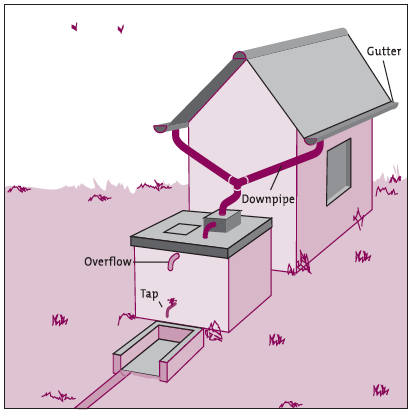Difference between revisions of "Captación de Agua de Lluvia / Captación de agua de lluvia en techos"
| Line 24: | Line 24: | ||
{| border="1" cellpadding="5" cellspacing="0" align="center" | {| border="1" cellpadding="5" cellspacing="0" align="center" | ||
|- | |- | ||
| − | ! width="50%" style="background:#efefef;" | | + | ! width="50%" style="background:#efefef;" | Ventajas |
| − | ! style="background:#f0f8ff;" | | + | ! style="background:#f0f8ff;" | Desventajas |
|- | |- | ||
| − | | valign="top" | - | + | | valign="top" | - Posible en casi todo tipo de clima <br> |
| − | - | + | - El agua de lluvia por lo general cumple con las normas de calidad para agua potable si el sistema está bien diseñado y mantenido |
| − | | valign="top" | - | + | | valign="top" | - Se requiere de almacenamiento para subsistir los períodos de sequía <br> |
|} | |} | ||
| − | === | + | ===Adaptación a cambios en el medio ambiente=== |
| − | ==== | + | ====Sequía==== |
'''Effects of drought:''' Water storage used up. <br> | '''Effects of drought:''' Water storage used up. <br> | ||
'''Underlying causes of effects:''' Lack of rainfall; Leaking linings due to bad construction; Storage not sufficient for demand – tanks are too expensive for volumes of water to outlast extended dry periods. <br> | '''Underlying causes of effects:''' Lack of rainfall; Leaking linings due to bad construction; Storage not sufficient for demand – tanks are too expensive for volumes of water to outlast extended dry periods. <br> | ||
Revision as of 02:31, 7 January 2016
| |
|
|
|
|
|
|
|
|
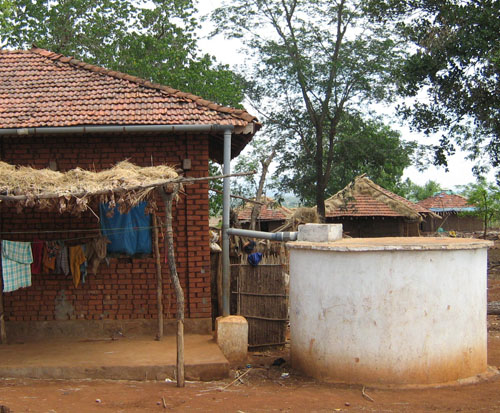
La captación de agua de lluvia se refiere a estructuras como viviendas particulares o escuelas, que recolectan el agua de lluvia y la almacenan en tanques subterráneos o superficiales para su uso posterior. Una manera de recolectar agua es la captación de agua de lluvia en techos, donde se puede utilizar una superficie de techo adecuada, como tejas, láminas de metal o plástico, pero no la paja u hojas de palma, para interceptar el flujo de agua de lluvia. Esto se hace en combinación con alcantarillas y bajantes pluviales (hechos de madera, bambú, hierro galvanizado o PVC) para abastecer a la vivienda de agua potable de alta calidad. Un sistema de captación de agua de lluvia para techos puede tener un almacenamiento subterráneo de 500 metros cúbicos, para servir a toda una comunidad, o puede ser simplemente un balde, ubicado debajo de un techo sin alcantarilla. Los sistemas de captación de agua de lluvia se han utilizado desde tiempos muy antiguos, y a través de la historia abundan ejemplos en todas las grandes civilizaciones.
Contents
Introducción
En muchos casos, es posible que no haya disponibilidad de aguas subterráneas o superficiales para beber. Es posible que el agua subterránea esté muy profunda o que esté contaminada con minerals y productos químicos como arsénico o sal. El agua superficial puede estar contaminada con material fecal o productos químicos. En estos casos, la captación de agua de lluvia puede ser una solución efectiva y económica.
Lo bueno del agua de lluvia es que cae sobre su techo, y casi siempre es de excelente calidad. Muchos estudios han demostrado que el agua de tanques en los techos con buena manutención por lo general cumplen con las normas de calidad para el agua potable. Permite tanto a las viviendas como a los edificios de la comunidad, escuelas y clínicas, administrar su propio suministro de agua para beber, uso doméstico y actividades generadoras de ingresos.
Ofrece el lujo de “agua sin caminar”, aliviando la tarea de acarrear agua, en especial para mujeres y niños. Cada contenedor de 20 litros de agua limpia puede ahorrar kilómetros de distancia a caminar hasta la fuente de agua limpia más cercana, y como el ir por agua los días fríos, húmedos o resbalosos no es muy agradable, incluso un poco de alivio es muy valorado. En Uganda y Sri Lanka, el agua de lluvia se recolecta tradicionalmente de los árboles mediante el uso de hojas o tallos de banana como canaletas provisorias. Esta facilidad está disponible en todas las viviendas donde cae lluvia, ya sea en las montañas o en las islas del mar salado.
Otra opción es el uso de agua de distintas fuentes. El agua salada o que contiene arsénico todavía puede ser lo suficientemente buena como para lavar y para ser utilizada con fines sanitarios. El agua de lluvia de alta calidad, recolectada y almacenada en un tanque puede utilizarse para beber y cocinar.
Condiciones adecuadas
La captación de agua de lluvia requiere de por lo menos una precipitación anual de 100 a 200 mm. Muchos sitios en América Latina tienen una precipitación de aproximadamente 500 milímetros al año.
Esto es muy adecuado incluso si el techo es pequeño. Por ejemplo, una casa de 5 x 6 metros (es decir 30 metros cuadrados), con una precipitación anual de 500 mm, recibe 15.000 litros de lluvia sobre su techo. Esta cantidad es suficiente para una familia de 5 miembros.
| Ventajas | Desventajas |
|---|---|
| - Posible en casi todo tipo de clima - El agua de lluvia por lo general cumple con las normas de calidad para agua potable si el sistema está bien diseñado y mantenido |
- Se requiere de almacenamiento para subsistir los períodos de sequía |
Adaptación a cambios en el medio ambiente
Sequía
Effects of drought: Water storage used up.
Underlying causes of effects: Lack of rainfall; Leaking linings due to bad construction; Storage not sufficient for demand – tanks are too expensive for volumes of water to outlast extended dry periods.
To increase resiliency of WASH system: Promote smaller tank structures so they are more manageable to construct and cover, while being more affordable to families; Reduce seepage due to poor construction & siting; Follow proper concreting guidelines (see drought effects on cement, below); Make tanks from cheaper lower quality materials and repair more often; Design the outlet of the tank so that there is no dead storage; Ensure the catchment itself is efficient (e.g. gutters); Improve access to micro-finance; Support the capacity of the government or private sector to be able to provide (for payment) a tankering scheme.
Drought effects on cement tanks
Effects of drought: Badly made concrete and cracked linings (e.g. in tanks, dams, waterways, wells, and other structures).
Underlying causes of effects: Less water used for curing; Impure water used for mixing.
To increase resiliency of WASH system: Ensure adequate mixing, ratios, purity of ingredients; Minimize water content in mixture; Ensure adequate curing.
More information on managing drought: Resilient WASH systems in drought-prone areas.
Making cement in regards to drought: Concrete production and drought.
Construction, operations & maintenance
Catchment & storage tanks
The flow of water can be intercepted in different ways. Different catchment types are used, such as roof catchment, paved surface catchment, surface catchment and riverbed catchment. The cheapest storage of all is to use the ground as storage area, a technique called groundwater recharge. It is accomplished by letting rainwater infiltrate in the ground. The recharge will locally lead to a higher water table, from which water can be pumped up when needed. Whether the infiltrated water raises the water table in a local area or is spread across a wider area depends on soil conditions.
If using storage tanks, structures made with ferrocement or brick-cement are the best and cheapest options, and they can be made locally. When a water tank is below ground, it is called a cistern. Among the different storage types are the underground tank, ferrocement tank, plastic-lined tank, etc. The size of the tank is a compromise between cost, the volume of water used, the length of the dry season, etc. It is advisable to first construct a small tank before attempting a large one. Storage tanks can additionally be filled up using pumps. Several pump systems can be used to lift the water from underground tanks, for example with a rope pump or with a deep well pump, which can elevate water up to a height of 30 m.
Keeping the water clean
Roof rainwater is usually of good quality and does not require treatment before consumption. If the house has a chimney, however, it is possible that the water becomes smoky. High chimneys are therefore preferred. Water is collected through roof gutters made of PVC, bamboo, etc. and stored. The most important thing to ensure water quality is a good lid, keeping out light and insects, and a filter, keeping out all kinds of dirt. A concrete lid protects the tank from pollution. Small fishes can be kept in the tank to keep it free from insects.
A foul-flush device or detachable down-pipe can be fitted that allows the first 20 litres of runoff from a storm to be diverted from the storage tanks. This is because runoff is contaminated with dust, leaves, insects and bird droppings. To prevent the use of dirty water, the runoff is then led through a small filter of gravel, sand and charcoal before entering the storage tank, or a filter is placed between the catchment structure and the storage tank. Where there is no foul-flush device, the user or caretaker has to divert away the first 20 litres at the start of every rainstorm.
The EMAS filtration system
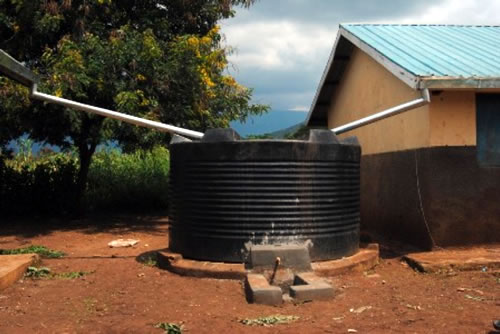
The EMAS system for rainfall collection uses various EMAS technologies as well as simple tools to convert rainwater into usable drinking water. If roof rainwater is being used, it is collected through a regular gutter. To filter the water, at the bottom of the gutter, a pitcher or ferrocement tank is placed, with an outlet pipe. A synthetic cloth bag is attached to the rim of the pitcher using an iron ring or wire, which fits around the edge. The bag should be cleaned every 3 months.
As water begins to collect, to avoid too much garbage collecting here, first some amount of water is deflected, along with most of the garbage. Hereafter, water can be directly sent to an EMAS cistern. It is advisable for multiple cisterns to be available for storage, depending on the size of the roof. Connect one cistern at a time to the outlet pipe. From here water can be pumped and distributed using a regular EMAS pump. The pump can also be connected to faucets and tanks around the house.
Maintenance
The system should be also checked and cleaned after every dry period of more than one month. The outsides of metal tanks may need to be painted about once a year. Leaks have to be repaired throughout the year, especially from leaking tanks and taps, as they present health risks. Chlorination of the water may be necessary.
Removal of debris and overhanging vegetation from gutters and the roof is important to prevent the gutter being clogged. Tank maintenance consists of physical inspection and repairing cracks with cement. Several studies have shown that water from well maintained and covered rooftop tanks generally meets drinking water quality standards if maintained rightfully.
Basic water quality testing is recommended during the first year, with further testing when water quality is in doubt. A low cost water test is the ‘HACH’ test, about US$1 per test. If contamination is suspected or when water quality needs to be guaranteed, the water can be treated in several ways.
Operation and maintenance (O&M) of shared roofs have more challenges. Rooftop-harvesting systems at schools, for instance, may lose water from taps left dripping. Padlocks are often needed to ensure careful control over the water supply. Ideally, one person should be responsible for overseeing the regular cleaning and occasional repair of the system, control of water use, etc. One option is to sell the water, which ensures income for O&M and for organizing water use. Where households have installed a communal system (e.g. where several roofs are connected to one tank), the users may want to establish a water committee to manage O&M activities. The activities may include collecting fees, and controlling the caretaker’s work and the water used by each family. External agents can play a role in the following O&M areas:
— monitoring the condition of the system and the water quality;
— providing access to credit facilities for buying or replacing a system;
— training users/caretakers for management and O&M;
— training local craftsmen to carry out larger repairs.
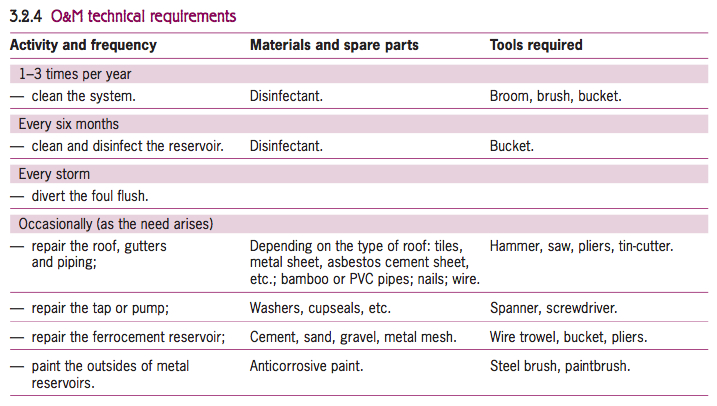
Potential problems
- corrosion of metal roofs, gutters, etc.;
- the foul-flush diverter fails because maintenance was neglected;
- taps leak at the reservoir and there are problems with the handpumps;
- contamination of uncovered tanks, especially where water is abstracted with a rope and bucket;
- unprotected tanks may provide a breeding place for mosquitoes, which may increase the danger of vector-borne disease;
- system may not fulfill drinking-water needs, during certain periods of the year, making it necessary to develop other sources or to go back to traditional sources temporarily;
- financial investment needed is not affordable - households or communities cannot afford to construct a suitable tank and adequate roofing.
Costs
Comparison of costs
- Brick cement tank of 6 m3: 3 bags of cement, 300 bricks, 3 kg of wire US$ 40
- Brick cement tank of 1 m3: 1 bag of cement, 100 bricks, 1 kg of wire US$ 20
- Plastic-lined tank of 5 m3: US$ 50
- Sub-surface ferro-cement tank of 60 m3: US$ 1,900
The bigger the volume of the storage tank, the lower the material demand (and thus costs) for construction per m3 of tank volume.
In Southern Africa, US$ 320 for a system with 11 m of galvanized iron gutter; a 1.3 m3 galvanized iron tank; downpiping; tap and filters; cost does not include transportation. Where roofs are not suitable for water harvesting, the cost of roof improvement and gutters will have to be added to the cost of a tank. Such costs varied from US$ 4 per m2 (Kenya, subsidized) to US$ 12 per m2. 1
Field experiences
- Rainwater harvesting is a technology which is extremely flexible and adaptable to a wide variety of settings, it is used in the richest and poorest societies on the planet, and in the wettest and driest regions of the world.
- In Ocara, Brazil, rainwater tanks have been constructed of concrete blocks.
- A low-cost option is the brick cement tank, used in for example Nicaragua and Ghana.
Akvo RSR projects
The following projects utilize rooftop rainwater harvesting.
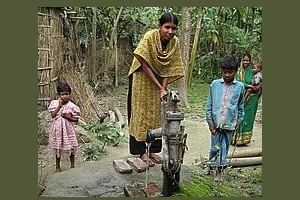 WaSH program in Rural Bangladesh |
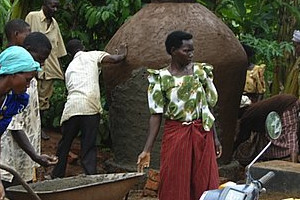 Raising awareness on rainwater harvesting |
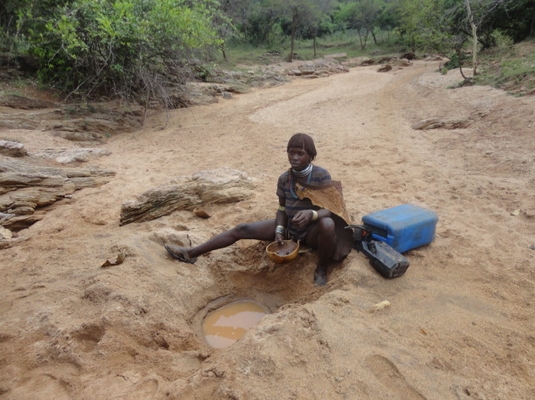 Rainwater for Green Schools Initiative |
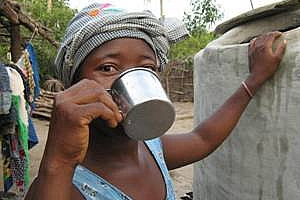 Rainwater harvesting in Guinee Bissau |
Manuals, videos, and links
Manuals
- Download the book "Roofwater Harvesting: A Handbook for Practitioners" from IRC.
- Booklet Smart Water Harvesting Solutions
- Smart 3R Solutions
Videos
by BSP-Nepal |
Harvesting rooftop rainwater |
Pushpam Singh |
Bangalore rural district |
External links
- Rainwater Harvesting Implementation Network (RAIN)
- Rainwater Harvesting information on Practical Action
- Indian website on rainwater harvesting
- Wikipedia article on rainwater harvesting
- Rainwater Harvesting info on the DTU unit of University of Warwick
- Rainwater Partnership
- Catch Water Where It Falls - Toolkit on Urban Rainwater Harvesting
- Akvo solution of the week 5
References
- ↑ 1.0 1.1 Brikke, François, and Bredero, Maarten. Linking technology choice with operation and maintenance in the context of community water supply and sanitation: A reference document for planners and project staff. World Health Organization and IRC Water and Sanitation Centre. Geneva, Switzerland 2003.
Acknowledgements
- Brikke, François, and Bredero, Maarten. Linking technology choice with operation and maintenance in the context of community water supply and sanitation: A reference document for planners and project staff or (alternative link). World Health Organization and IRC Water and Sanitation Centre. Geneva, Switzerland 2003.
- CARE Nederland, Desk Study Resilient WASH systems in drought-prone areas. October 2010.
